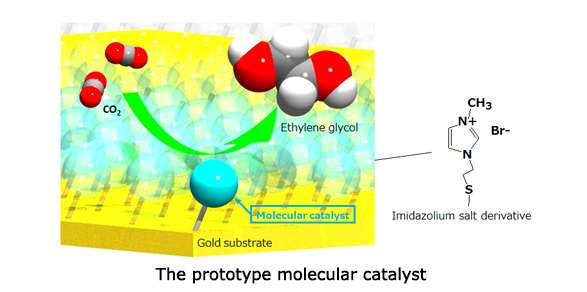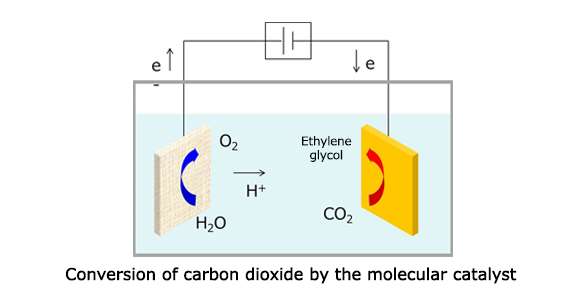New molecular catalyst for artificial photosynthesis converts carbon dioxide directly into ethylene glycol

Toshiba has developed a prototype of a highly efficient molecular catalyst that converts carbon dioxide into ethylene glycol, a useful industrial raw material, without producing other and unwanted by-products.
The new catalyst can be used in artificial photosynthesis powered by solar energy to convert carbon dioxide and water into carbon compounds. Most artificial photosynthesis technologies use a two-electron reduction conversion process, producing carbon monoxide and formic acid. Others can achieve direct multi-electron reduction, but tend to produce many by-products, and their separation can be problematic. Toshiba's new molecular catalyst converts carbon dioxide into ethylene glycol via multi-electron reduction. The conversion is highly efficient, with a Faraday efficiency of 80%.
In recent years a continuing rise in atmospheric concentrations of carbon dioxide, contributing to global warming, and depletion of fossil fuels remain a concern. As awareness of the need for increased use of renewable energy continues to grow, Toshiba is developing artificial photosynthesis technologies that use solar energy to convert carbon dioxide and water into carbon compounds, as means for solving problems related to fossil fuel depletion and global warming.
Most artificial photosynthesis technologies convert carbon dioxide into substances such as carbon monoxide and formic acid via two-electron reduction. Copper is being investigated as a catalyst for direct conversion of hydrocarbons via multi-electron reduction, but the production of many by-products remains a challenge.
Toshiba has developed a new molecular catalyst consisting of an imidazolium salt derivative applied to a metal surface in a high-density coating. When connected to an external power source and used to reduce carbon dioxide dissolved in an aqueous solution, it produces ethylene glycol with a Faraday efficiency of 80%. Molecular interactions between the catalyst coated on the metal surface and carbon dioxide molecules achieve a previously impossible reaction. Toshiba researchers working on the project believe that, in addition to promoting this reaction with carbon dioxide, the molecular catalyst also serves as a reaction field for a complex ten-electron reduction, rather than a simple two-electron reduction. The resulting ethylene glycol is a versatile industrial raw material that can be used in the manufacture of PET bottles, polyester fibers and various plastics.

Toshiba will continue development of the molecular catalyst towards the practical application of artificial photosynthesis technologies by the 2020s.
This technology was described in an article published online in the peer-reviewed journal Physical Chemistry Chemical Physics of the Royal Society of Chemistry.
Journal information: Physical Chemistry Chemical Physics
Provided by Toshiba Corporation




















